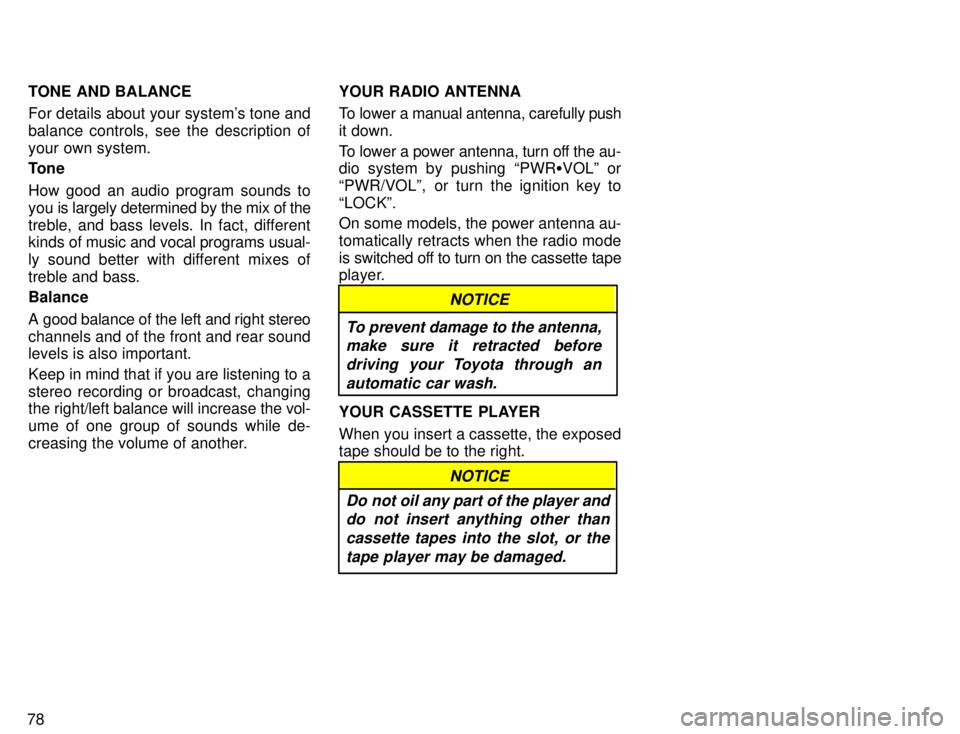Page 82 of 196

78TONE AND BALANCE
For details about your system's tone and
balance controls, see the description ofyour own system.
Tone
How good an audio program sounds to
you is largely determined by the mix of the
treble, and bass levels. In fact, different
kinds of m
usic and vocal programs usual-
ly sound better with different mixes of treble and bass. Balance
A good balance of the left and right stereo
channels and of the front and rear sound levels is also important. Keep in mind that if you are listening to a
stereo recording or broadcast, changing
the right/left balance will increase the vol-
ume of one group of sounds while de-
creasing the volume of another. YOUR RADIO ANTENNA
To lower a manual antenna, carefully
push
it down.
To lower a power antenna, turn off the au-
dio system by pushing PWR �VOLº or
PWR/VOLº, or turn the ignition key to LOCKº.
On some models, the power antenna au-
tomatically retracts when the radio mode
is switched off to turn on the cassette tape
player.
To prevent damage to the antenna,
make sure it retracted before
driving your Toyota through anautomatic car wash.
NOTICE
YOUR CASSETTE PLAYER
When you insert a cassette, the exposed tape should be to the right.
NOTICE
Do not oil any part of the player and do not insert anything other than
cassette tapes into the slot, or the tape player may be damaged.
Page 88 of 196

84ILLUMINATION CONTROL LOGIC
On some audio-units, when the instru-
ment panel lights are on, the letters on op-
erable buttons of the mode in current use
light up together with the mode selection and eject buttons. RADIO RECEPTION
Usually, a problem with radio reception
does not mean there is a problem with
your radioÐit is just the normal result of
conditions outside the vehicle.
For example, nearby buildings and terrain
can interfere with FM reception. Power
lines or telephone wires can interfere with
AM signals. And of course, radio signals
have a limited range, and the farther youare from a station, the weaker its signal
will be. In addition, reception conditions
change
constantly as your vehicle moves.
Here are some common reception prob-
lems that probably do not indicate a prob- lem with your radio: FM
Fading and drifting stationsÐGenerally,
the effective range of FM is about 40 km
(25 miles). Once outside this range, you
may notice fading and drifting, which in- crease with the distance from the radio
transmitter. They are often accompanied by distortion.
Multi-pathÐFM signals are reflective,
making it
possible for two signals to reach
your antenna at the same time. If this hap-
pens, the signals will cancel each other
out, causing a momentary flutter or loss of
reception.
Static and flutteringÐThese occur when
signals are blocked by buildings, trees, or other large objects. Increasing the bass
level may reduce static and fluttering.
Station swappingÐIf the FM signal you are listening to is interrupted or weak-
ened, and there is another strong station
nearby on the FM band, your radio may
tune in the second station until the original
signal can be picked up again. AM FadingÐAM broadcasts are reflected by the upper atmosphereÐespecially atnight. These reflected signals can inter-
fere with those received directly from the radio station, causing the radio station tosound alternately strong and weak.
Station interferenceÐWhen a reflected
signal and a signal received directly froma radio station are very nearly the same
frequency, they can interfere with each
other,
making it difficult to hear the broad-
cast.
StaticÐAM is easily affected by external sources of electrical noise, such as high
tension power lines, lightening, or electri- cal motors. This results in static.
CARING FOR YOUR CASSETTE
PLAYER AND TAPES
For high performance from your cassette
player and tapes:
Clean the tape head and other parts regu-
larly. � A dirty tape head or tape path can de-
crease sound quality and tangle your
cassette tapes. The easiest way to
clean them is by using a cleaning tape.
ÐCar audio system operating hints
Page 188 of 196

184
Engine compartment (Canada)
7. DOME 15 A: Car audio system, power
antenna, interior light, clock, ignition
switch light, personal lights, door courtesy
lights
8. TAIL 10 A: Tail lights, license plate
lights
9. PANEL 10 A: Emergency flashers,
heater control system, air conditioning
cooling system, gauges and meters,
clock, car audio system overdrive indica-
tor light, glovebox light, cigarette lighter,
instrument panel lights
10. A.C 10 A: Air conditioning cooling
system
11. HEAD (RH) 10 A: Right-hand head-
lightInstrument panel
12. HEAD (LH) 10 A: Left-hand head-
light
13. HEAD (HI RH) 10 A: Right-hand
headlight (high beam), hi-beam indicator light
14. HEAD (HI LH) 10 A: Left-hand head-
light (high beam)
15. HEAD (LO RH) 10 A: Right-hand
headlight (low beam)
16. HEAD (LO LH) 10 A: Left-hand
headlight (low beam)
17. DRL 7.5 A: Daytime running light sys-
tem
18. 4WD 15 A: A.D.D. control system,
four-wheel drive control system, rear dif- ferential lock system 19. GAUGE 10 A:
Gauges and meters,
back-up lights, cruise control system,
power antenna, power door lock control
system, electronically controlled automatic
transmission system, starting system,
charging system, heater control system
20. TURN 10 A: Turn signal lights, emer-
gency flashers
21. ECU-IG 15 A: Cruise control system,
anti-lock brake system, shift lock system
22. WIPER 20 A: Windshield wipers and
washer
23. IGN 7.5 A: Discharge warning light,
SRS airbag system
24. RADIO 7.5 A: Car audio system,
power antenna
25. CIG 15 A: Cigarette lighter, clock,
power rear view mirrors, back-up lights,
shift lock system
26. ECU-B 15 A: SRS airbag warning
light, daytime running light system, cruise control system, anti-lock brake system